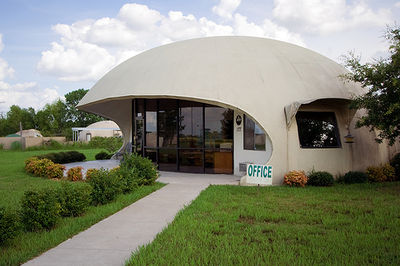Monolithic Dome: Difference between revisions
No edit summary |
mNo edit summary |
||
| Line 15: | Line 15: | ||
'''How it’s Built:''' For a 6-meter dome, you need: 50 bags of cement, 2500’ roll of basalt reinforcing or fiberglass, about 5 cubic meters of small size concrete aggregate, an Airform that can be used hundreds of times, a small inflator fan and a few workers primarily with hand tools. | '''How it’s Built:''' For a 6-meter dome, you need: 50 bags of cement, 2500’ roll of basalt reinforcing or fiberglass, about 5 cubic meters of small size concrete aggregate, an Airform that can be used hundreds of times, a small inflator fan and a few workers primarily with hand tools. | ||
''Related: use of [[Basalt Fibers]] (includes videos)'' | ''Related page: use of [[Basalt Fibers]] (includes videos)'' | ||
==Applications and Product Ecology== | ==Applications and Product Ecology== | ||
* | * residential, for humans and animals | ||
* | * cistern: underground water storage | ||
* for storage: grain, char, manure/compost | |||
* | * | ||
Revision as of 13:38, 12 March 2011
Template:Category=Housing and construction
Monolithic Domes are constructed following a method that requires a tough, inflatable Airform, steel-reinforced concrete and a polyurethane foam insulation. Each of these ingredients is used in a technologically specific way. This technology was developed by the Monolithic Dome Institute (MDI). The domes can be designed to fit any architectural need: homes, cabins, churches, schools, gymnasiums, arenas and stadiums, bulk storages, landlord dwellings and various other privately or publicly owned facilities.
The dome, when finished, is earthquake, tornado and hurricane resistant (FEMA rates them as "near-absolute protection" from F5 tornadoes and Category 5 Hurricanes). Recently, a number of monolithic domes constructed using MDI techniques have survived major disasters...
Ecoshells
MDI has also developed the technology to build so-called "EcoShells". These are simple structures to provide for the basic needs of a family. They are designed specifically to answer the needs of shelterless people worldwide. They are strong structures that can withstand natural disasters, fire, termites and rot. In underdeveloped areas with hot climates, EcoShells make affordable, low maintenance, sturdy housing. In industrialized nations, EcoShells make superior workshops, garages, storage sheds, etc.
EcoShells are easy to build, easy to teach others to build and fast to construct. They require no serious equipment or education – just simple materials, cement and reinforcement available almost everywhere, and workers willing to work. Concrete is layered onto the exterior of an inflated Airform. The basic unit is a concrete floor with a 6-meter diameter. Preferably, the dome should have a sink; a walled-off toilet and a walled-off shower. The balance of the dome is open.
It has been estimated that Haiti, for example, needs approximately 200,000 EcoShells to house up to 1 million people. Although that sounds like a very daunting task, it really is not. A few good workers can build an EcoShell in three to five days.
How it’s Built: For a 6-meter dome, you need: 50 bags of cement, 2500’ roll of basalt reinforcing or fiberglass, about 5 cubic meters of small size concrete aggregate, an Airform that can be used hundreds of times, a small inflator fan and a few workers primarily with hand tools.
Related page: use of Basalt Fibers (includes videos)
Applications and Product Ecology
- residential, for humans and animals
- cistern: underground water storage
- for storage: grain, char, manure/compost
